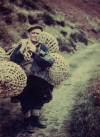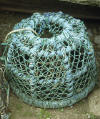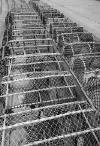|
Datblygiad y Cewyll Lobster Pot Development
(Cliciwch ar y lluniau i'w gwneud yn fwy/Click on
photos to enlarge). |
||||
|
Denu cimychiaid i’r cawell trwy ddefnyddio pysgod neu ryw abwyd arall yw’r egwyddor sydd y tu cefn i’r holl gewyll cimychiaid. Nid yw’r cimwch yn gallu dianc yn rhwydd o’r cawell oherwydd bod siâp fel twmffat ar y fynedfa neu’r mynedfaoedd. Basgedi gwiail gyda gwaelod fflat a mynedfa ar y top oedd y cewyll cynnar. Roeddynt wedi eu heilio â gwiail ac wedi eu trymhau gan gerrig a rwymwyd wrth waelod y cawell. O amgylch blaen gorllewinol Pen Llŷn, yn cynnwys Ynys Enlli, roedd gan y cewyll waelod crwn yn hytrach na gwaelod fflat. Roedd tair carreg wedi eu rhwymo wrth ochr allan i bob cawell yw trymhau. Byddai hyn yn eu galluogi i "roi" yn y cerrynt cryf sydd yw cael yn yr ardal hon. Buasai’r cewyll gwaelod fflat wedi torri neu wedi troi drosodd. Ysgrifennodd Bingley (1800) y gwnaed y cewyll o amgylch Ynys Enlli o "willow exactly in the shape of a wire mousetrap with the cone inverted." Er eu gwneud â defnyddiau modern, ffrâm dur â rhwyd nylon amdani, cawell potel inc oedd yn boblogaidd a amgylch Ynys Enlli hyd y 1980au pan gymerwyd eu lle gan gewyll parlwr. Yn raddol, cymerwyd lle y cewyll crwn gan gewyll ar ffurf "D," sef y cewyll Albanaidd. Ar y dechrau roeddynt wedi cael eu gwneud o ffrâm goed gyda rhwyd amdano. Yn ddiweddarach, gwnaed y ffrâm o biben polythene a choed. Bellach, gwnaed fframiau’r cewyll yn fasnachol o haearn wedi ei alfanu neu’i orchuddio â phlastig er mai parhau i weldio’u fframiau wnâi rhai pysgotwyr. Prynir mwy a mwy o gewyll oddi wrth y gwneuthurwr. Hefyd prynir cewyll fesul cam, o’r ffrâm i fyny, i’w cwblhau gan y pysgotwyr at ei ddant neu’i ofynion ei hyn. Parheir y sawl sy’n pysgota’n rhan amser neu o ran pleser i wneud eu cewyll eu hunain gan ddefnyddio amrywiaeth o ddefnyddiau. Datblygodd dyluniad y cewyll o gawell syml gyda mynediad ar ei phen i gewyll â un neu ragor o fynedfaoedd yn eu hochr. Ffactor pwysig a hefyd mater o ddewis yw’r maint ar draws y mynediad. Mae’r mynediad llydan yn caniatáu i gimwch sy’n fwy o faint i fynd i mewn i’r cawell ond hefyd yn ei alluogi i ddianc yn fwy rhwydd. Y datblygiad mwyaf yn nyluniad cewyll yw y cawell parlwr. Gelwid hi’n hynny oherwydd bod y tu mewn i’r cawell wedi’i wahanu’n ddwy gan dwmffat wedi’i ffurfio o rwyd. Anodd iawn yw i’r cimwch ddianc unwaith yr aethai i mewn i’r ail siambr neu "barlwr." Mae’r ffaith ei bod yn anoddach i’r cimwch ddianc yn golygu y gellid gadael cawell am rai dyddiau cyn i gimwch ddianc ohoni. Yn y cyfamser, efallai fod y pysgotwr wedi halio, wedi gwagio ac wedi abwydo nifer tebyg o gewyll a thrwy hyn wedi pysgota dwbl y nifer o gewyll neu wedi pysgota am rywbeth arall fel chwalciaid neu gorgimychiaid. |
. Cewyll â gwaelod fflat - Rhosneigr - Flat bottomed ink-well pots.
Gwneud cawell Aberdaron/Weaving an Aberdaron lobster pot (Jenkins, 1974).
Evan Morannedd - yn carrio cewyll Aberdaroni Borth Meudwy/carrying Aberdaron lobster pots to Porth Meudwy. (Diolch i Rhiw.com am fenthyg y llun hwn).
Cawell potel inc fodern/Modern ink-well pot.
Amrywiaeth o gewyll cartref/Mixture of homemade pots.
Cewyll gyda ffrâm polythene a choed gyda cnyw wedi'i blethu o wiail/Pots made of a polythene and wooden frame with a woven willow entrance.
Cewyll cartref gyda cnyw caled ar y top/Home made rigid top entry pots.
Cawell gyda cnyw meddal yn y naill ochr/Twin soft eyed side entry pot.
Cewyll parlwr gyda'r cnyw ar yr ochr/Side entry parlour pots.
Cawell -weldmesh -pot.
Cewyll parlwr - mae'r parlwr wedi'i wau â lleinyn nylon gwyrdd/Parlour pots - the parlour is knitted from green nylon twine.
|
The principle behind all lobster pots is the attraction of lobsters by means of fish or other baits into a container from which its escape is made difficult by the funnel-like entrance of entrances. Early lobster pots were round baskets with flat bottoms and an entrance at the top. They were woven from willow and weighted by stones attached to the bottom. The pots around the western tip of the Llŷn Peninsula, including Bardsey Island, had round as opposed to flat bottoms and were weighed down with three stones attached to them on the outside. This allowed them to “give” in the strong currents prevelant in the region. The flat bottomed pots would have been damaged or rolled over. Bingley (1800) wrote that the lobster pots used around Bardsey Island were “made of willow exactly in the shape of a wire mousetrap with the cone inverted.” Although finished in modern materials, a steel frame covered with nylon mesh, ink-well pots were the favoured design for fishing around Bardsey Island well into the 1980s when they were superseded by parlour pots. Round pots were gradually replaced by D-shaped Scottish creels. Initially, they were made of a wooden frame covered with netting. The frame was later made of polythene pipe and wood. Today, pot frames are commercially made of galvanised or plastic coated steel although some fishermen continue to weld their own. Completed pots are increasingly bought from the manufacturer. Pots in various states of completion, from the frames upwards, are also bought and completed by the individual fisherman to his own taste or requirement. Part-time and hobby fishermen continue to make their own pots from various materials. Pot design has evolved from the simple top entry pot to pots with one or two side entrances. The diameter of the pot entrance is an important factor and a matter of preference. A wider entrance will allow larger lobsters into the pot but will also make it easier for any lobsters to escape. The greatest advance in pot design has been the parlour pot so called because the interior of the pot is divided in two by a mesh funnel. Once the lobster has entered the second chamber or “parlour” of the pot it is very difficult for it to escape. The superior retention qualities of the parlour pot means that the pot may be left for several days without any lobsters escaping from it. In the meantime, a fisherman may have hauled, emptied and baited a similar number of pots effectively doubling his fishing effort or have occupied himself in another fishery such as fishing for whelks or prawns. |
||










